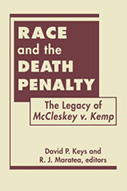Race and the Death Penalty: The Legacy of McCleskey v. Kemp

Editors: David P. Keys and R. J. Maratea
Publisher: Boulder, CO: Lynne Rienner Publishers, 2016. 219p.
Reviewer: Tim Lyman | September 2016
This timely and multifarious view of the U.S. Supreme Court’s 1987 McCleskey decision rejecting the legendary Baldus study’s rigorous demonstration of discrimination in the state of Georgia comprises 11 articles by 14 authors citing 42 U.S. Supreme Court decisions and nearly 400 papers, articles and studies. The 11 articles here – four overviews, two studies, and five essays – cover the many facets of the decision in a book as well-indexed as it is well-cited, allowing the reader to easily drill-down into areas of interest.
The book begins with an historic overview by the editors. In the long view, McCleskey is right in line with step-by-step events watering down the emancipation proclamation and constitutional amendments won in the Civil War. Every time these “compromises” are made ‒ Dred Scott in 1857 fomenting the Civil War, Cruikshank in 1876 ending Reconstruction after the Colfax massacre, Plessy in 1896 hastening Jim Crow through its “separate but equal” dictum, on through the “black codes” of the twentieth century South – the old view, that expanding and protecting the rights of blacks comes at the expense of the rights of whites, is reinforced. McCleskey in turn enables the “stand your ground” laws and Trump campaigns of the present day.
Tony G. Poveda’s enlightened overview of the legal treatment of the Baldus study invokes C. Wright Mills’ 1959 theory of sociological imagination – its assertion of the importance of tensions at the intersection of the biological and the historical, of “personal troubles of milieu,” represented by the person McCleskey, and “public issues of social structure,” represented by the evidence of the Baldus study – to frame the legal dilemma facing the Court, and to give insight into how the Court felt pushed both to violate stare decisis (legal precedence) and to bizarrely extend the concept of mens rea (the criminality of intent) to its own equal protection jurisprudence — now requiring a government action with discriminatory impact to be intentional in order to be legally relevant. Four justices, two on each side (Powell and O’Connor for, Blackmun and Stevens against) of the decision, came to deeply regret McCleskey.
Mills further framed sociological enquiry by emphasized the need to analyze the structure of a society as a whole, and Robert M. Bohm gives an overview of the societies abolishing capital punishment – Venezuela and Costa Rica in the nineteenth century, 16 countries by 1977, and now 97 countries through 2013 – noting that 87% of known executions (excluding China) in 2012 were carried out in five countries (in order, Iran, Iraq, Saudi Arabia, USA, and Yemen), and that 81% of USA executions were in the South. He continues with a thorough review of the reasons to retain the death penalty, debunking old ideas of deterrence, incapacitation, cost savings, and revenge, leaving us with the newer idea of closure for victim families, a bitter promise at death sentencing that in fact usually never comes about, or occurs only after very many years.
The final overview article is a summary of post-Gregg (the 1976 reinstatement of executions) studies by Vito and Higgins, noting that persistent findings of discrimination indicate a shift from overt racism to structural racism; a racism that has no need of intention, as it is built into society’s structures (one example being that from 1986-2010, five grams of crack cocaine triggered the same mandatory minimum penalty as 500 grams of powder). They liken structural racism to Hubert M. Blalock, Jr.’s 1967 racial threat theory, which posits that as racial minority populations grow, positive perceptions of capital punishment increase. They cite studies that “show a previous tradition of vigilantism interacts with the increase in racial population to explain recent death sentences,” and conclude with the famous memo from the rookie Justice Scalia to his colleagues in McCleskey that “[s]ince it is my view that unconscious operation of irrational sympathies and antipathies, including racial, upon jury decisions and (hence) prosecutorial decisions is real, acknowledged in the decisions of this court, and ineradicable, I cannot honestly say that all I need is more proof.”
This leads us to Ross Kleinstuber’s thoughtful and clear essay on racism and intent. He reviews the genesis of the capital sentencing scheme created in Gregg and, comparing it to so many studies finding bias in “a society that remains highly stratified by race,” concludes that “the problem is not that most people are purposefully racist,” but that “no single individual is immune from being influenced by deeply entrenched and highly racialized cultural labeling of nonwhites as criminals.” In other words, today’s structural racism, unlike the old overt racism, is quite clearly devoid of intent.
A very large problem was thus created when the concomitant concept of structural mitigation ‒ despite breadth of mitigation being the linchpin of capital jurisprudence post-Gregg, with Supreme Court decisions talking of “thickly contextual social biography” with “virtually no limits” on relevance and “no need for direct connection” in mitigation presentations ‒ was ruled out by McCleskey. It was a stunning rejection of stare decisis by the newly minted Rehnquist Court, and this refusal to allow consideration of discrimination as a social process left nonwhites with an accumulation of aggravating stigmata, such as long lists of prior charges from profiling, no ability to make bail and help with their defense, the proliferation of new aggravators added each year by state legislatures, and the war on (some) drugs.
That same year of hearings, 1986, the Court defined in Lockhart that the jury of peers assured by the sixth amendment is to mean a cross-section of “distinctive groups” in the venire pool, meaning race, gender, and ethnicity groups, not actual jurors holding diverse opinions about the death penalty ‒ a distinction that has been called “ahistorical and textually absurd” by scholars. This further codified the process of “death qualification” established in Witherspoon and Wainwright. By 2012, according to Gallup polling, 34% of Americans found the death penalty morally wrong, and were excludable for cause from serving on death penalty juries under death qualification.
Jamie L. Flexon elucidates this movement to exclude a set of attitudes, then moves on to review articles about jury psychology that explore how “jurors who fail to recognize their biases are likely parties to symbolically formalized social processes that can promote discriminatory outcomes.” Whereas egalitarian folk, with a feel for due process, better apt to acknowledge their stereotypes and self-regulate, are less likely to be chosen as jurors.
Which brings us to R. A. Maratea’s broadly contemplative essay on the interplay of morality, empiricism, and eighth amendment concerns. Chief Justice Burger invoked old traditions of Blackstone and the Rights of Man, cemented an open view of mitigation, and coined the Lockett Doctrine in that 1978 case when he wrote that “the need for treating each defendant in a capital case with the degree of respect due the uniqueness of the individual is far more important than in noncapital cases.” Yet how moral can administering capital punishment be? The work of moralist abolitionist Hugo A. Bedau is discussed at length, including his caution that the “death penalty symbolizes unlimited impersonal power over the individual.”
The fact that solid empirical work will not go away can aid a search for morality. The problem is that the science of statistics is so often mistaken for the trade in statistics, a staple in all manner of commerce today. Witness the distrust in Maratea’s concluding quote from Justice Powell’s Supreme Court McCleskey opinion [emphasis added by reviewer]:
Even Professor Baldus does not contend that his statistics prove that race enters into any capital sentencing decisions or that race was a factor in McCleskey’s particular case. Statistics at most may show only a likelihood that a particular factor entered into some decisions. There is, of course, some risk of racial prejudice influencing a jury’s decision in a criminal case . . . the question is at what point that risk becomes constitutionally unacceptable (McCleskey v. Kemp 1987a:309).
Perhaps when systemic rather than random?
The two studies in the book are both multivariate logistic regression studies. The first is of capital cases in Georgia over 10 years straddling the centuries, 1995-2004, where Lee, Paternoster, and Rocque repeat the methodology of the Baldus study and find very much the same patterns as were found in the 1970s Georgia data. In both data sets, rates of capital charging in murder cases were over-represented in BkW cases, under-represented in BkB cases, and slightly elevated in WkW cases.
The second study is of Oklahoma over the 38 years 1973-2010, a welcome event from a less-studied, leading death penalty state, served up with sharp writing by Keys and Galliher, and many interesting facets of the predictor variables. However, the case counts presented in Appendix B only cover Phase One of the three phase study, and, in what little we are given, various typos, columns that don’t add up, and other errors leave this reader skeptical, particularly about the base count of only 8% of WkW murder cases being charged capitally (137/1,696), while 53% of BkB cases are thus charged (348/659). This is anomalous enough, relative to other studies in the South, to demand further analysis. Compare this with the same categories in Baldus’ Georgia (32% WkW and 15% BkB) and the above post-Baldus Georgia (43% WkW and 15% BkB) studies. The variable particulars, as they are based on the counts, are diminished by the problems in Appendix B.
The book concludes with two short essays by Franklin E. Zimring. The first is about the death penalty’s dirty little secret, which is that lawyers matter tremendously. California’s legal institutions, from public defender offices to civil liberties unions, appellate projects, and resource centers, make executions there rare. There is plenty of evidence that states in the South actively sabotage these sorts of institutions.
Zimring’s final essay on the race of the victim and American capital punishment rises to the level of beauty in its incisiveness and tone. He finds the doomed efforts to make capital punishment an acceptable part of American justice a wonder. No executing country in history has ever tried so hard to do it with legal principles intact. But “due process and efficient executions are always on a collision course,” he writes. The bittersweet taste of pathos infuses our modern Gregg era attempts to weigh aggravators against mitigators as if they were assets and debits in a cost benefit analysis, or fortes and faults in an online dating application.
Only three of the 1,300 executions since 1978 have been the work of the federal government. Over 80% of the state executions have been in the South. A study of 1,238 rape convictions in seven states in the South between 1930 and 1972 found that BkW cases got the death penalty 36% of the time, and all other race combinations 2% of the time. That sounds like an old anthropology text about island society taboos. One wonders what the spoils of winning a civil war really are. Zimring sees race-of-victim injustice as part and parcel of attempts to be principled about wanting to weed out the worst of the worst, as we like to say, in this particular society with this particular racial history. “As soon as the criteria for death sentences must be highly selective, they will represent the dominant sentiments of the majority social group,” he concludes. Also, that the cynicism of continuing to tinker with the machinery of death in the face of massive evidence of its failure demonstrates, in the words of Justice Brennan, “a fear of too much justice.”
Tim Lyman is a statistical analyst affiliated with Northeastern University’s Institute for Security and Public Policy at the School of Criminology and Criminal Justice.


